Chicago firefighters battled a 3-11 alarm warehouse fire Thursday afternoon in the Lawndale neighborhood on the city’s west side.
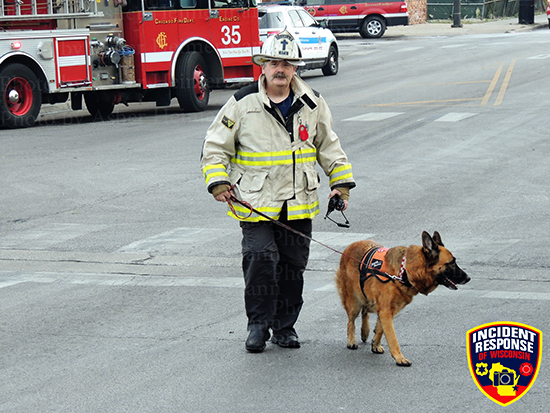
Asher Heimermann photo
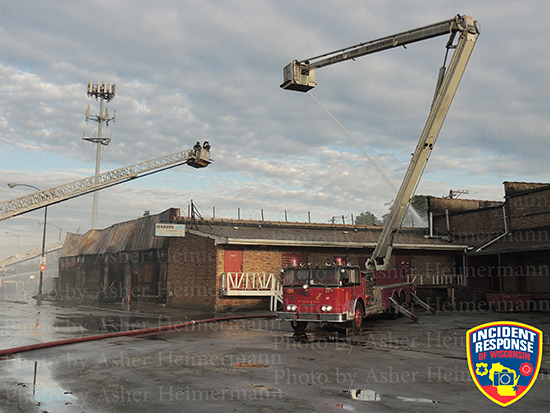
Asher Heimermann photo
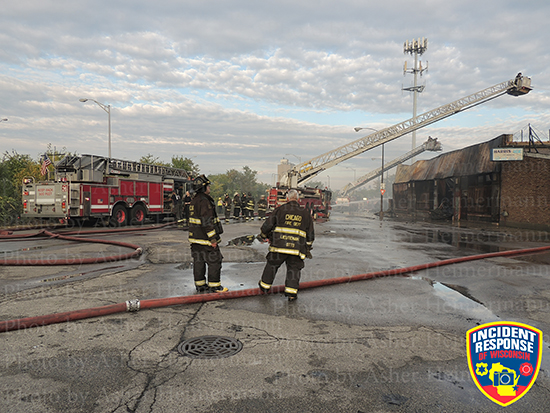
Asher Heimermann photo
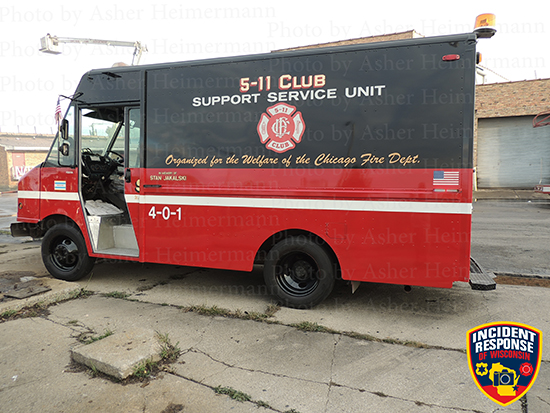
Asher Heimermann photo
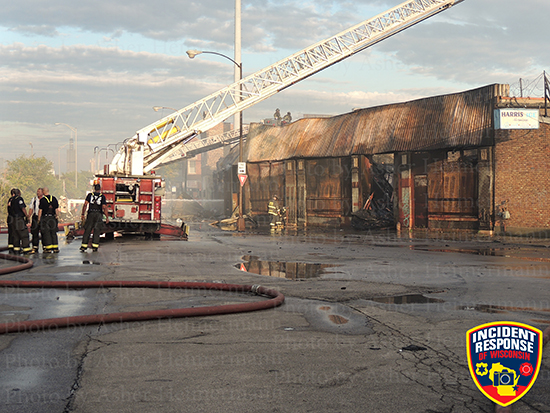
Asher Heimermann photo

Asher Heimermann photo

Asher Heimermann photo

Asher Heimermann photo

Asher Heimermann photo

Asher Heimermann photo
Tags: 3-11 Alarm fire in Chicago, Asher Heimermann, CFD Chaplain Father John, Chciago FD Spartan engine, Chicago Fire Department, fire scene photos, heavy smoke at commercial building fire.
This entry was posted on September 28, 2014, 2:10 PM and is filed under Fire Scene photos. You can follow any responses to this entry through RSS 2.0. Both comments and pings are currently closed.
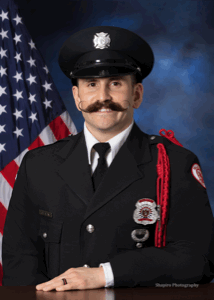
For the finest department portraits and composites contact Tim Olk or Larry Shapiro.
Arclite theme by digitalnature | powered by WordPress
#1 by Bill Post on October 19, 2014 - 11:36 PM
Scott I did have my doubts about the pumps on RS 1 being used myself however since Engine 35 usually is the company that brings RS (Reserve Snorkel 1) to the fire don’t some of their crew also operate the Snorkel boom and therefore Engine 35 would automatically go out of service as they need to take the Snorkel to the fire and they would still need to operate it whether they actually would use it’s pumps or not. Or are you saying that another company operates the Snorkel once Engine 35 gets it to the scene?
Yes I also heard the good news of Smeal getting the rights to build the Snorkel from the now defunct American La France. And I had been wondering if they have begun retooling their factory so that they can finally start building Snorkels once again? I have a good hunch that Chicago will probably use the new Smeal Snorkels for the long awaited new Snorkel/Squads ,once Smeal resumes building the Snorkel. I understand that the city and Rosenbauer are in some type of a legal suite and counter suite in regards the the city wanting some modification done to the specs on the proposed new Squads and I really don’t know if that has anything to do with the “Rosenbauer Snorkels” themselves. EIther way Chicago would be better off just buying the Snorkels from Smeal rather then buy a “reinvented ” type of Snorkel from Rosenbauer that hasn’t even been built or proven yet.
Thanks for the information.
#2 by Scott on October 19, 2014 - 9:41 PM
CFD’s RS-1 does not pump. It is only for the elevated stream. No engineer on it, therefore no pumping. Eng 35 can not have their engineer pump it because then E35 is out-of-service. Any apparatus that is to pump must have its own Engineer.
As far as Snorkel’s (the boom) I believe Smeal has bought the rights to Snorkel and I understand once the booms come up to todays standards they will be produced.
#3 by 0.03 on October 1, 2014 - 7:50 AM
Bill your post on automatic aid is very good. Remember though this is a double edged sword. Look at communities that are or were downsizing and saying “we will just use MABAS or mutual or auto aid to fill in” Skokie is a great example. They take care of their village by providing proper fire protection and EMS that they don’t have to relay on everyone else. Which in essence doesn’t tax the surrounding communities. Obviously things are different everywhere go north to lake county where some coverage areas are over 50 square miles and you need auto aid companies to help with response times or they’re just plain closer to the emergency then that departments next firehouse.
#4 by Bill Post on October 1, 2014 - 4:12 AM
Phil there is no question that the system that is used in the Phoenix area seems be a great system as all of the Fire Departments work as if they were one United Fire Department yet each fire department still maintains is separate “Logo” Colors and Identity so they can still claim to be “independent”.
It would be good to see more fire departments in the Chicago area operate like that. Yes I know that there is Red Center in the north suburbs and Du Comm in the Western suburbs however not all of the north suburban fire departments have signed up to operate like that. An example is Skokie. Skokie has a great fire department and gives great service so don’t be mistaken about the fire department itself. The thing that I am getting at is the automatic aide policy of Skokie could be better. An example is that in Morton Grove’s east end (just across the border from Skokie) , the NIles Truck company will respond as the first due Truck from at least 3 miles west instead of sending Skokie’s Truck 18 or Tower Ladder 16 which are a mile or less east of the Skokie/Morton Grove border.
As far as a local fire department goes Skokie does deserve the Class One rating if you consider that in effect they maintain 4 Engines companies out of 3 Stations ( 5 if you count Squad 18 which is really a Squad/Pumper). Rescue 17 is really the 4th Engine company and is dispatched as such when responding to fires (especially on the east end of town) and they do have some Truck and Squad equipment on it as well. They really started calling it Rescue 17 when it had become an ALS engine around 1980 as there was no ambulance running out of Station 17 however when they opened the New Station 17 at 8157 N Central Park in 2003 and put Ambulance 17 in service Rescue 17 lost it’s ALS status so now they just call it Rescue 17 to differentiate them from Engine 17. They are also often designated as a RIT company and they even have RIT written on the the side of the Engine.
#5 by MJ FF on October 1, 2014 - 12:20 AM
My question is off-topic from this 3-11. But does anybody know a breakdown of Chicago’s run totals for 2013? Fires, non-fire incidents, EMS …And maybe even numbers for 2014 so far? Thanks.
#6 by Drew Smith on September 30, 2014 - 9:45 PM
1979 was the year Alan Brunacini became the fire chief in Phoenix.
I recall reading that when the Ladder Tender concept was originally developed the Chief Bruno was able to get funding for a fifth member allowing the tender to respond with 2-3 on the tender and the balance remained on the ladder itself. In some cases the tender responded alone and the ladder stayed in quarters available to meet up with the tender if dispatched to a fire. I think this was a sales pitch to get the fifth member and do not think they run this way now. I also seem to recall that the original LTs were assigned to the TDAs and that part of the justification was the difficulty of getting the TDAs into trailer parks/manufactured home communities.
#7 by Phil Stenholm on September 30, 2014 - 9:26 PM
BILL:The automatic aide thing started in 1979, when Phoenix rebuiilt & relocated their Station #15 (which was only about 25 years old at the time) a mile further north to the Phoenix-Glendale border, and Glendale built their new Station #4 (Station #54) at the Glendale-Phoenix border. Also, Glendale turned over their dispatching to Phoenix at that time, as Phoenix and Glendale began to respond automatically to each other’s calls, with the closest unit dispatched by the Phoenix Fire Alarm Office regardless of jurisdiction. Phoenix and Glendale began joint training & implemented Chief Brunacini’s new “Fireground Incident Command” system at that time, too, as well as a Rapid Intervention Team (RIT) – another Phoenix invention – responding to working fires.
Within a very short period of time, Tempe came on board, followed by almost all of the other fire departments or fire districts that border Phoenix, and eventually most all of the fire departments in Maricopa County.
The Phoenix consortium operates almost like a county fire department, with all departments trained the same way at the same place, and with the same dispatch center. There is a constant staffing of four FF per engine or ladder company in all jurisdictions, so it doesn’t matter which fire department responds to a call, they all do things the exact same way. Whether it be Phoenix or Sun Lakes, or Scottsdale or Glendale, it’s all the same.
As far as the Phoenix Fire Department ladder companies are concerned, the PFD had five TDA (1, 9, 10, 12, and 20) and a snorkel (4) which ran as a truck company, by the mid-1960’s. They also had 30 fire stations, so the ratio of engine companty to truck company was about five-to-one at that time.
The PFD replaced some of their TDA with ALF RMA trucks in the 1970’s and added six additional truck (ladder) companies in the 1970’s (for a total of 12) as the number of fire stations (and engine companies) had increased to about 40.
The snorkel was replaced in about 1980 by a FDNY-type Mack aerialscope, and I think they eventually had two or three of them in service, but they are long-gone now.
The Phoenix F. D. Bronto Sky-Lift (“The Big Unit”) was demolished in a roll-over crash a few years ago, and it was replaced by another one. Tempe has a 114-ft Bronto Sky-Lift in service at Station 276 (near the Arizona State University Campus). There is at least one more Bronto Sky-Lift in service somewhere in Arizona, but I can’t remember where.
#8 by Admin on September 30, 2014 - 10:09 PM
Glendale has a Bronto as well
#9 by Bill Post on September 30, 2014 - 11:57 AM
Phil. I am familiar with the system in Phoenix Arizona however I wasn’t aware of the early pre 1980 Paramedic Squads that were in service prior to the ALS Engine companies going in service.
Since then at first about 1/3 to one half of the Phoenix fire department ambulances or “Rescues” were converted to ALS ambulances and as of the the last few years all of the ambulances have been converted to ALS ambulances by now having every Ambulance with one paramedic and one emt assigned to it on every shift.
As of now all of the Engine companies are also ALS units and of the 36 current Ambulances 22 of them are full time and the other 14 of them are part time which means that they are only in service during the busier hours which generally speaking would be from the mid afternoon until in the late evening. I am not exactly sure what the “power shift” hours are in Phoenix but they would be generally according to what I just mentioned.
The Ladder Tenders have indeed become popular the Phoenix area and another interesting thing is that all of Phoenix’s Truck companies are also equipped with Elevating Platforms. Thirteen of the their Trucks are Tower Ladders and one of them (Truck 9) is a Bronto Skylift like you had mentioned. Of course they run with a very small ratio of Trucks to Engnes as they only run with 14 Truck companies as opposed to about 65 Engine companies. Part of the reason is because all of the the fire department in the Metropolitan Phoenix area run on automatic aide which means the nearest companies are always dispatched to the incident without regard to whose town or jurisdiction the emergency is in. For example If the fire is Phoenix but a Glendale Truck or Engine is located closer then the Glendale Engine and Truck will be dispatched as the first due companies.
In Chicago automatic aide is only found in a few places and in a few communities but in the Phoenix area that is universally practiced and accepted as a Standard Operating Procedure.
Despite the fact the Phoenix area fire departments are dispatched as if they were one large fire department the Phoenix fire department could use a few more Truck companies. They should have at least 20 of them as opposed to only 14. The Ladder tender concept does usually work well and has saved them maintenance costs however what happens if an Aerial device or Ladder is needed when the Ladder tender is out on the street and gets dispatched to a multistory structure fire.While that probably doesn’t happen very often that still can happen. I know that outside of downtown that most of the buildings are probably single level , at least I would hope that to be the case.
#10 by Phil Stenholm on September 30, 2014 - 10:33 AM
BILL: In the 1970’s the Phoenix Fire Department ran with six paramedic rescue squads (like Squad 51 on the TV show “Emergency”) and private ambulances provided transport to hospitals.
Te six rescue trucks were going constantly and often had long response times because of the large first-due area assigned to each of the rescues, plus often having to respond out of its own district to cover for another rescue not available.
The PFD took the six rescue trucks out of service in 1980 and replaced them with “ALS paramedic engine companies” (I believe Phoenix was the first FD to do this), where all of the paramedic gear carried on the rescue trucks was moved to the ALS engine, and two of the four members of the engine company were paramedics. Initially every-other engine company was ALS, so sometimes a BLS engine engine or a BLS ladder company would respond as the “first-responder” followed by an ALS engine company from further away. Now all engine companies are ALS.
Also, Phoenix replaced the private ambulance medical transport system with fire department ambulances, except the ambuances were BLS only. The ALS engine company would go back in service from the scene if there was no transport or if the transport was BLS, but the two paramedics aboard the ALS engine companies would ride in the ambulance to the hospital if it was an ALS transport, and then the engine would follow the ambulance to the hospital, pick up the two FF/PM, and go back in service from there.
Chief Alan Brunacini of the Phoenix Fire Department (the man behind “Fireground Incident Command”) noted the problem with the wear & tear associated with ladder trucks as “first-responders” on EMS calls, and so the PFD began to place “ladder tenders” in service with the ladder companies.
The ladder tender is basically a squad-type vehicle (most are essentially a “heavy-rescue”) with a crew-cab, and the four-person ladder company responds to EMS calls in the ladder tender rig. This cuts back significantly on the wear & tear on the expensive ladder trucks (like Ladder 9’s Bronto Sky-Lift). The ladder tenders also respond to traffic accidents requiring extrication (what they would call a “pin-in” in Chicago).
The only two negatives associated with this system is (#1) you need a fire station with space for both a ladder truck and a ladder tender, and (#2) when the ladder company is out of quarters in the ladder tender (even if it is back in service from the EMS call), the ladder truck is not available to respond to fires until the company has physically returned to quarters. That’s why the ladder tenders are equipped with most of same basic “truck gear” (forcible entry tools, pike poles, axes, saws, ventilation fans, et al) that is carried on a ladder truck (minus the ladders of course).
The ladder tenders have worked out very well in Phoenix (so well that most all of the other the other fire departments in the area use ladder tenders, too), saving literally millions of dollars in maintenance & replacement costs over the years.
#11 by Bill Post on September 30, 2014 - 4:23 AM
Tom I too have thought about what the best replacement would be for the 1982 Seagrave / Pierce 85 foot reserve Snorkel. There is no question that the Chicago Fire Department has been making good use of it for it elevating stream capabilities. One of the reasons why they kept it so long is that It was still a relatively new rig when the Snorkel companies were taken out of service. It was put in service as Snorkel 1 during May of 1982 and 16 months later on September 19th 1983 the Snorkels as separate fire companies were taken out of service.As you know 3 of the larger 75 foot Snorkels became part of the Squad companies for a few years until smaller 55 foot Snorkel/Squads were purchased and put in service in 1987 and 1988. As the Chicago’s first Tower Ladders didn’t go in service until early 1986 for the at least 3 or 4 years the Chicago Fire Department actually had about 3 to 4 “Reserve Snorkel’s” out in the field. The “North side” Reserve Snorkel was located at Engine 112’s house and that was the 1982 Seagrave/ PIerce that we are talking about. The “Central” reserve Snorkel was located at Engine 107’s station and the “South Side” Reserve Snorkel was initially located at Engine 72’s house. They had been shifted around a bit and by early 1990’s when there were at least 9 large Tower Ladders in service it was decided to only keep the 1982 Seagrave as the only “Reserve Snorkel” and around then is when they were relocated to Engine 42’s station “downtown”. That said ,this is my idea for a replacement.
My Idea for the Chicago Fire Department is to purchase either two 134 foot Bronto Skylift articulated Aerial Platforms which are market in the United States by E/One or the other option would be for the CFD to purchase 2 136 foot Telstar Articulating Platforms which are marketed and sold by Spartan/Erv in the United States. The Telstar Platform is very similar to the Bronto Skylift except it is manufactured by Gimaex company which is also a European company just like “Bronto Skylift” is.
Both products are like extra Large Snorkels as they articulated similar to a Snorkel.
My Idea is actually to kill 2 birds with one stone as by purchasing Platforms in the 134 to 136 foot range it would allow to Chicago fire department to get back into the “High Ladder Club”. High Ladder basically means any Aerial Platform or Ladder that goes higher then 110 feet.
As you probably recall the Chicago fire department used to have as many as 2 135 foot Aerial Ladders. Truck 1 , known as Aerial Tower 1 had run with a 135 foot Aerial Ladder until approximately 2006 and Truck 3 had also run with one until 1995 when the apparatus crashed into a building.
So I think it would make sense to put either a Bronto Skylift or a Telstar Platform in service at Aerial Tower 1 in the Loop and at Truck 3 in the Loop and they would be able to 135 foot Aerial Ladders that Chicago used run with with 135 foot “Snorkel type” Platforms which are overall safer for fire and rescue work at “heights” as opposed to climbing up 135 feet on a narrow Aerial Ladder.
Due to the high cost involved in purchasing a 135 foot Aerial Platform I am suggesting this for a few years “down the road” after Chicago gets some new “much needed” Tower Ladders and new Snorkel/Squads.
I know that some people would have reservations about purchasing the 135 Platforms as of the wear and tear that running on Ambulance assist runs can do to the bodies however the larger Aerial Platform apparatus (if worse comes to worse) can be exempted from being dispatched on Ambulance assist runs if wear and tear does become a problem.
So far Phoenix Arizona has been using a 114 foot Bronto Skylift and Memphis Tennessee uses a 100 foot model as well as Melrose Park and Elmwood Park.
This would be “killing 2 birds with one stone”.
The Chicago fire department was using “High Aerials from 1960 until 2006 for over 45 years. If you recall Chicago had purchased two 144 foot Aerials from the Magirus company in 1960 on Mack B model Chassis and they ran until the mid 1970s. Then Chicago had purchased a 135 foot Morita Lift “Elevator Ladder” on a Hendrickson Chassis that ran on Truck 1, before the 135 foot E/One Aerial Ladders were purchase in the 1980’s.
The Bronto Skylifts and the Telstar Platforms are used all over the world so they have been proven so it would make sense to consider purchasing a few of them in the future. They are basically Supersized Snorkels.
In Europe the Bronto Skylift makes Platforms that go as high as 367 feet or 33 approximately 33 floors up. The Highest One that are built for the North American Market are 134 feet however. The 134 foot ones shouldn’t be a problem considering that the Chicago fire Department has used Aerials of that size or larger in previous years.
#12 by Bill Post on September 30, 2014 - 3:06 AM
That’s a very good question Fred and I too wonder about it. I really haven’t attended that many fires with that 661 on the scene as of late. I wouldn’t really be surprised if they are not used. The normal procedure has always been for an Engine company to lead out into the Snorkel and if they were to have ever used the built in pump they probably would still have to be “fed” by an Engine company. Even when the 1982 Seagrave/Pierce was a fully manned company which was for less then 2 years before becoming a “Reserve Snorkel” they usually would run with about 3 men on board and the driver would have to be a “qualified Engineer”. If they ever do use the on board pump then they would have to use the engineer off of Engine 35 who usually accompanies the Snorkel to the fires when special called.
Just like you I really have my doubts about the on board pump being used even though the Chicago Fire Department actually did have a total of 6 Snorkels (7 if you include Snorkel/Squad 7 at O”Hare Field ) which were delivered with on board pumps.
The Chicago Snorkels that were delivered with on board pumps were
1. Shop G 288 The 1971- Ford/Pierce 55 foot Snorkel assigned to Snorkel
3 and then 6.
2 . Shop G 316. The 1972 Oshkosh/Pierce 75 foot Snorkel assigned to Snorkel 3 and damaged in the Cities Service Levy Ink Division fire on May 27 1973. It was then used as a Reserve Snorkel until Snorkel 6 was relocated from Engine 110 to 112 on March 15th 1979 and was reassigned as Snorkel 6. It was renumbered as Snorkel 3 on May 25th 1981.
3. Shop G 337. The 1974 Oshkosh/Pierce 75 foot Snorkel assigned to Snorkel 5 and renumbered as Snorkel 1 on May 25th 1981. Subsequently it was reassigned as Snorkel 4 on March 16th 1983. On September 19th/20th was reassigned as Squad 1 A.
4. shop G 338. The 1974 Oshkosh/Pierce 75 foot Snorkel assigned to Snorkel 4 and renumbered as Snorkel 2 on May 25th 1981. Was reassigned as Squad 2 A on September 19th 1983.
5. Shop G 339. The 1974 Oshkosh/Pierce 75 foot Snorkel assigned to Snorkel 3 and was renumbered as Snorkel 5 on May 25 1981 and subsequently renumbered as Snorkel 6 on September 2nd 1982.
Was reassigned as Squad 6 A on September 19th 1983 and was renumbered again as Squad 5 A on December 18th 1987.
6. Shop D 424. The second of 2 twin 1975 model Oshkosh/FMC/Bean 1,250 GPM pumpers that were built specifically for O”Hare International Airport. It was numbered as Engine 12 and as was retrofitted with a 55 foot Snorkel in 1979. It was put in service as Squad 6 at O”Hare Airport on February 16th 1982. It was subsequently renumbered as Squad 7 on September 2nd 1982.
#13 by Tom Foley on September 29, 2014 - 11:40 PM
While I’m sure there are more needs than there is money, if Snorkels are again produced or there is a similar option, do you think Chicago FD would ever seek to replace this Snorkel with something similar?
I’m mainly asking if they would seek out a Snorkel larger than those on their squads (like the 85′ reserve).
It’s at an awful lot of 3-11s and above, it would seem. And, you have to respect the department’s decision to keep this unit in service for over 30 years. It must be valuable to them.
#14 by Fred on September 29, 2014 - 11:28 AM
Bill – not to beat a dead horse, but does the RS 1 unit 6-6-1 ( ’82 Seagrave/Pierce) use it’s pump at the scenes? Pic’s I have seen seem to show just high pressure feed lines running to it.
#15 by Isaac on September 28, 2014 - 10:44 PM
Thanks for the info. All I expected was the make and model and you went above and beyond that. Thanks again!
#16 by Asher Heimermann on September 28, 2014 - 7:22 PM
I apologize for the watermark but I’ve caught a few people stealing my images.
#17 by Bill Post on September 28, 2014 - 5:41 PM
Isaac so as not to confuse you I was also including the history of Chicago’s 1975 Hendrickson Pierce 55 foot Snorkel/Squad which really had perhaps the most interesting history of Chicago’s Snorkels as it had been assigned to so many companies and saw service as Chicago’s famous SS 1, Snorkels 4 and 5, reserve duty and then running as Chicago’s Squad 5 both as a one piece and a 2 piece Squad/Snorkel company.
#18 by Bill Post on September 28, 2014 - 5:32 PM
The Reserve Snorkel is a 1982 Seagrave/Pierce 85 foot Snorkel and was equipped with a 1,500 GPM pump to kick up the water pressure of any lines that were hooked up to the Snorkel. It was only in service as a front line company for about 16 months before becoming a Reserve company.When half of Chicago’s 6 Snorkel Companies (at the time) were taken out of service and the other half (3 Snorkels) were redesignated as the second pieces to our new (at the time) 2 piece Squad companies on September 19th 1983.
The Seagrave Snorkel had been assigned to Snorkel company 1 which had been located at Engine 18’s old station which was at 1123 W Roosevelt rd and had been assigned to Snorkel 1 since May 1982. As a reserve Snorkel they were originally relocated to Engine 112’s station and a few years later to Engine 42’s house before being relocated Engine 35’s house. Even though the Seagrave was Chicago’s newest Snorkel at the time. The two piece Squads were usually assigned one of three 1975 model Oskosh Pierce 75 foot Snorkels until the Spring of 1987 when Squads 1 and 2 were given new Spartan/E One 55 foot Snorkel/Squads and Squads 1 and 2 had become one piece Snorkel Squads for several years. A little over a year later Squad 5 received a 1988 Spartan/E/One (matching) 55 foot Snorkel Squad however they were “totaled” in a roll over accident and Squad 5 resumed running as a 2 piece Squad/Snorkel with the 1975 model Hendrickson/Pierce 55 foot Snorkel which was originally assigned to Snorkel Squad (SS 1) until SS 1 was taken out of service on Oct 3rd 1980 and was then assigned to the newly renumbered Snorkel 4 in 1981 and subsequently renumbered as in 1982 Snorkel 5 then becoming a reserve Snorkel on September 19th 1983 before being assigned to the 2 piece Squad companies in 1987 and ended it’s long in service life as Squad 5 around early 1997.
#19 by J on September 28, 2014 - 5:21 PM
Holy Watermark….
#20 by Isaac on September 28, 2014 - 2:57 PM
What year and make is reserve snorkel 1 (6-6-1)?